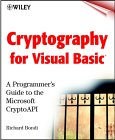 |
Cryptography for Visual Basic
A Programmer's Guide to the Windows Crypto API
Authored by Richard Bondi |
|
This book is targeting the CryptoAPI, a Windows interface to cryptography. In my opinion, the coverage is fair, but not what you would expect from this kind of book. At least it wasn't what I had expected. If you want to read about cryptography, chances are you're better off with another book.
Bondi starts with a simple explanation of cryptography in general, and touches all common issues regarding the application of cryptography in real-word situations. He proceeds with a simple overview of the CryptoAPI, and which of the common cryptograhic tasks the CryptoAPI can support.
In chapters 3 and 4, Bondi tires his audience with an endless (or so it seemed) explanation of basic VB concepts. Perhaps the stuff will prove useful to someone, but in my opinion, those people shouldn't be reading a book about cryptography. The very basics of VB should be familar before you embark on a fairly advanced subject like cryptography. Skip these chapters if you can.
Finally, we get down to the core -- the API. Oh, wait; there's something else. Bondi has created a set of COM classes to wrap the CryptoAPI up nicely for VB developers. Although I applaude the effort, and especially the open source license, I feel the book's focus is drifting. Instead of explaining the CryptoAPI in detail, the remainder of the book is divided between the CryptoAPI and the BondiAPI.
The sudden shift of focus degrades the usefulnes of this book. Now we have to learn two interfaces, and have to remember which method belongs to which interface. I agree that a good background in either interface will make the other easier to understand, but not when they're presented at the same time. The making of the Wiley CryptoAPI COM Objects is a nice story, but it's not what I came here to read. Once again, I applaud the effort, but I was expecting more CryptoAPI and less COM objects.
Having blown some steam, I have to say that the book isn't without value. I know more about the CryptoAPI now than before, and I know where to go to find COM objects or to learn more. In a sense, the pragmatic in me is satisfied, but the researcher is not.
Last update: 2025-12-17
Copyright 1995-2025 VBI


